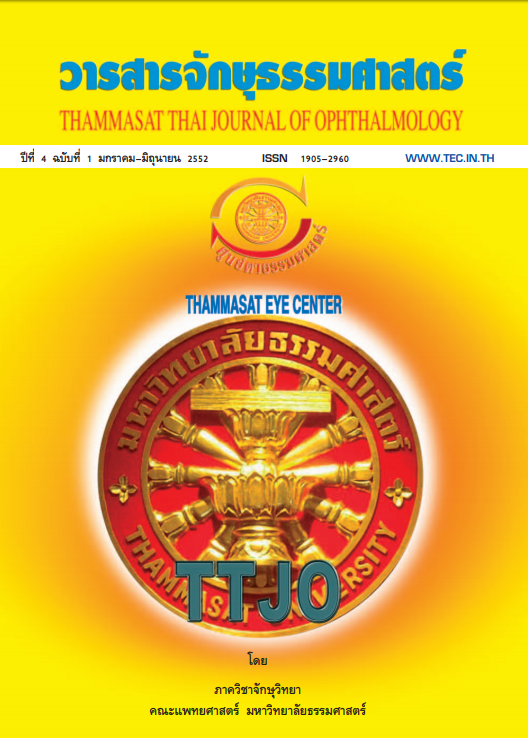ผลการใช้ 0.05% Cyclosporine eye drops ในผู้ป่วยที่ใส่เลนส์สัมผัสและมีอาการตาแห้งร่วมด้วย
Main Article Content
Abstract
วัตถุประสงค์: เพื่อศึกษาผลของการใช้ยาหยอดตา 0.05% Cyclosporine ในผู้ป่วยที่ใส่เลนส์สัมผัสและมีอาการตาแห้งร่วมด้วย
วิธีการ: ศึกษาในผู้ป่วย 30 ราย (มีผู้ป่วย 4 รายที่ต้องออกจากการศึกษา 1 รายเนื่องจากทนผลข้างเคียงของยาหยอดตา 0.05% Cyclosporne ไม่ได้ อีก 3 รายไม่สามารถมาตรวจให้ครบ 3 เดือนได้) โดนหยอด 0.05% Clclosporine ในตาข้างหนึ่งและหยอดน้ำตาเทียม (เพื่อเป็นยาหลอก) ในตาอีกข้างวันละ 2 ครั้ง เป็นระยะเวลา 3 เดือน ดูผลการรักษาที่ 1 เดือน 2 เดือน และ 3 เดือน บันทึกคะแนนอาการตาแห้ง, ค่า tear breakup time, ค่า Fluorescein staning และค่า Schirmer's test
ผลการศึกษา: พบว่าคะแนนอาการตาแห้งลดลง, ค่า tear breakup time มากขึ้น, ค่า Fluorescein staining ลดลง, ค่า Schirmer's test เพิ่มขึ้นหลังได้รับยา 1 เดือน 2 เดือน และ 3 เดือน เหมือนกันทั้งกลุ่มทดลองและกลุ่มควบคุม โดยไม่มีความแตกต่างกันอย่างมีนัยสำคัญ (P> 0.05)
สรุป: จากการศึกษานี้ การรักษาด้วยยาหยอดตา 0.05% Clclosporine ได้ผลในผู้ป่วยที่ใส่เลนส์สัมผัสและมีอาการตาแห้งร่วมด้วย แต่ไม่แตกต่างจากน้ำตาเทียม ดังนั้นควรจะต้องมีการศึกษาหาสาเหตุของเลนส์สัมผัสที่ทำให้ตาแห้งเพิ่มเติม ออกแบบวัสดุที่ใช้เลนส์สัมผัสให้ดีขึ้นเพื่อให้มีผลต่อการผลิตน้ำตาและการ ระเหยของน้ำตาให้น้อยที่สุดหรือไม่มีเลย และต้องวิจัยและพัฒนายาเพื่อให้ได้ผลในการรักษากลุ่มผู้ป่วยที่ใส่เลนส์ สัมผัสและมีอาการตาแห้งร่วมด้วยให้ดียิ่งขึ้นต่อไป
Efficacy of 0.05% Cyclosporine eye drops for the Treatment of Dry Eye in Comtact Lens Users
Objective: To evaluate the efficacy 0.05% Cyclosporine eye drops for the treatment of dry eye in contact lens users.
Methods: Thirty contact lens patients with dry eye symptoms were included in this study (four cases were dropped out, one case had side effect of Cyclosporine, three cases were not able to complete 3 months follow up). 0.05% Cyclosporine eye drops were used in one eye and artificial tear were used in the other eye two times per day for three months. Symptoms of dry eye, tear break-up time, Fluorescein staining, Schirmerûs test were collected at baseline, one month, two months and three months after treatment.
Results: After treatment one month, two months and three months of treatment, dry eye symptoms and Fluorescein staining were decreased, tear break-up time and Schirmerûs test were increased, in both Cyclosporine and placebo groups .
Conclusions: 0.05% Cyclosporine and artificial tear drops could relieve dry eye symptoms in contact lens users but there was no statistically significant difference between groups (P > 0.05). The factors contributing to dry eye symptoms in contact lens users should be further studied. Contact lens materials and designs should be improved to provide greater comfort and less dry eye symptoms. New drugs should also be developed to handle this problem.
Article Details
References
Richdale K, Sinnott LT, Skadahl Elisa, Nichols JJ. Frequency of and Factors Associated With Contact Lens Dissatisfaction and Discontinuation. Cornea. 2007;26(2):168-174.
Fonn D. Targeting contact lens induced dryness and discomfort: what properties will make lenses more comfortable. Optometry & Vision Science. 2007;84(4):279-285.
Donnenfeld E. Pflugfelder SC. Topical ophthalmic cyclosporine: pharmacology and clinical uses. Surv Ophthalmol. 2009;54(3): 321-38.
Hom MM. Use of cyclosporine 0.05% ophthalmic emulsion for contact lens-intolerant patients. Eye Contact Lens. 2006; 32(2):109-11.
Willen CM, McGwin G, Liu B, Owsley C, Rosenstiel C. Efficacy of cyclosporine 0.05% ophthalmic emulsion in contact lens wearers with dry eyes. Eye Contact Lens. 2008; 34(1):43-5.
Schein OD, Munoz B, Tielsch JM, et al. Prevalence of dry eye among the elderly. Am J Ophthalmol. 1997;124:723-728.
McCarty CA, Bansal AK, Livingston PM, et al. The epidemiology of dry eye in Melbourne, Australia. Ophthalmology. 1998;105:1114-1119.
Lekhanont K, Rojanaporn D, Chuck RS, Vongthongsri A. Prevalence of dry eye in Bangkok, Thailand. Cornea. 2006;25(10): 1162-7.
Bron AJ, Evans VE, Smith JA. Grading of Corneal and Conjunctival Staining in the Context of Other Dry Eye Tests. Cornea. 2003; 22(7):640-650.
Cakmak SS, Unlü MK, Karaca C, Nergiz Y, Ipek S. Effects of soft contact lenses on conjunctival surface. Eye Contact Lens. 2003;29(4):230-3.
Chen Q, Wang J, Shen M, Cai C, Li J, Cui L, Qu J, Lu F. Lower volumes of tear menisci are associated with dry eye symptoms in contact lens wearers. Invest Ophthalmol Vis Sci. 2009;Mar 11.
Arita R, Itoh K, Inoue K, Kuchiba A, Yamaguchi T, Amano S. Contact lens wear is associated with decrease of meibomian glands. Ophthalmology. 2009;116(3):379-84.
Guillon M, Maissa C. Contact lens wear affects tear film evaporation. Eye Contact Lens. 2008; 34(6):326-30.


